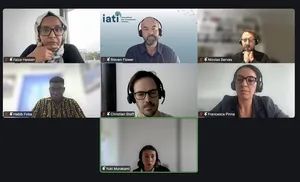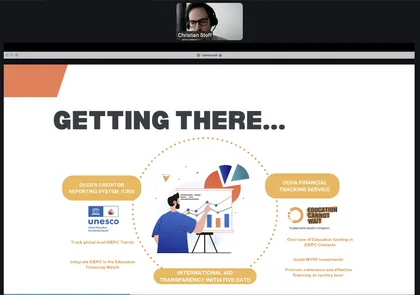Breaking Silos in Education Financing: The Role of Data in Crisis Contexts

The IATI Secretariat joined the webinar “Education Financing in Crisis – The Role of Data in Breaking Silos”, hosted by the Inter-agency Network for Education in Emergencies (INEE), Education Cannot Wait (ECW), and the UNESCO Global Education Monitoring Report (UNESCO GEM).
The meeting explored how open data can strengthen the way education financing is tracked and coordinated in crisis contexts.
The discussion was grounded in the findings of the joint ECW–UNESCO GEM policy paper, "Funding for Education in Crises: Data in Distress," and enriched by insights from the International Aid Transparency Initiative (IATI), the Global Education Cluster (GEC), and the Local Education Group of Chad. Together, participants examined how stronger data collaboration can enhance transparency, coordination, and accountability in education financing.
Understanding the financing landscape
Drawing on complementary international datasets—the IATI Standard, the OECD’s Creditor Reporting System (CRS), and the OCHA Financial Tracking Service (FTS)—the policy paper demonstrated how integrating data sources provides a more complete, near real-time view of global education aid flows across humanitarian and development channels.
According to CRS data, 92% of global education in emergencies and protracted crises (EiEPC) funding in 2023 was channeled through development aid, compared to 70% in 2017.

“To fund education effectively in crisis, we must first see the full picture.”
– Christian Stoff, Education Cannot Wait
Key insights from the discussion
- Integrating data strengthens visibility.
Combining IATI, CRS, and FTS data provides a fuller picture of financial flows and supports more coherent planning across the humanitarian–development nexus.
- Gaps persist across platforms.
ECW’s comparison of FTS and IATI datasets revealed that only 2% of transactions appeared in both data systems. This highlights the risk of underestimating education financing when relying on a single reporting source.
- Country-level access is essential.
As Habib Foba, Local Education Group Coordinator in Chad, explained, national actors often “chase data rather than use it,” emphasising the need for frameworks that make global data more accessible and actionable at country level.
- Thematic tagging reveals hidden investments.
Many education-related projects addressing protection, displacement, or gender are classified as development aid, even though they serve humanitarian needs. A thematic tracking approach—focusing on what is funded rather than how it is labeled—can help bridge silos.
- Usability beyond transparency.
As Nicolas Servas from the Global Education Cluster noted, “Having a comprehensive picture of funding levels will lead to a better understanding of our achievements and what we need to do for a comprehensive education response.” Data must be accessible, user-centered, and designed to support decision-making.
“Stronger collaboration between major platforms is needed to harmonize definitions, cross-check data, and reduce duplication.” - Yuki Murakami from the GEM Report.
What's next
Towards harmonised and actionable education finance data
As Steven Flower from the IATI Secretariat observed:
“The challenge isn’t just about more data—it’s about making data work together.”
Harmonised reporting standards and interoperable systems are essential to improve the quality and usability of education finance data.
💡IATI remains supportive of this vision by:
- Strengthening interoperability with FTS and OECD systems.
- Supporting countries to use IATI data directly within national frameworks.